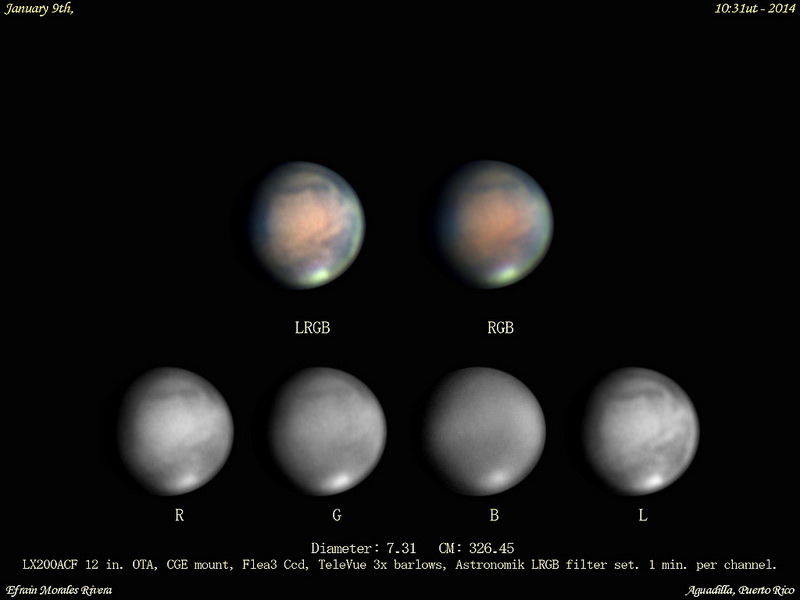Get those telescopes ready: the coming months offer Earthbound viewers some great views of the planet Mars.
Mars reaches opposition for 2014 on April 8th. This is approaching season represents the best time to observe Mars, as the Red Planet is closest to us in April and rises in the east as the Sun sets opposite to it in the west. Mars reaches 10” in apparent size this week. Mars is already beginning to show surface detail through a moderate-sized telescope as it continues to grow. In mid-February, Mars currently rises at around midnight local, and rides high to the south at local sunrise.
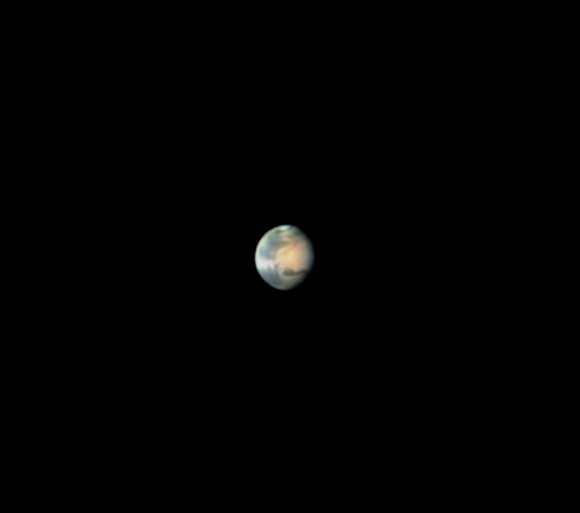
The 2014 opposition of Mars offers a mixed bag for observers. Hanging around 5-10 degrees south of the celestial equator just east of the September equinoctial point in Virgo, viewing opportunities are roughly equal for both northern and southern hemisphere observers. At opposition, Mars will shine at magnitude -1.5 and present a 15.2” disk, only slightly larger than the near minimum apparition of 2012, when it appeared 13.9” across. This is a far cry from the historic 2003 appearance, when Mars nearly maxed out at 25.1” across.
Why such a difference? Because the planet Mars has an exceptionally eccentric orbit. In fact, the eccentricity for Mars is 9.3% compared to 1.7% for the relatively sedate Earth.
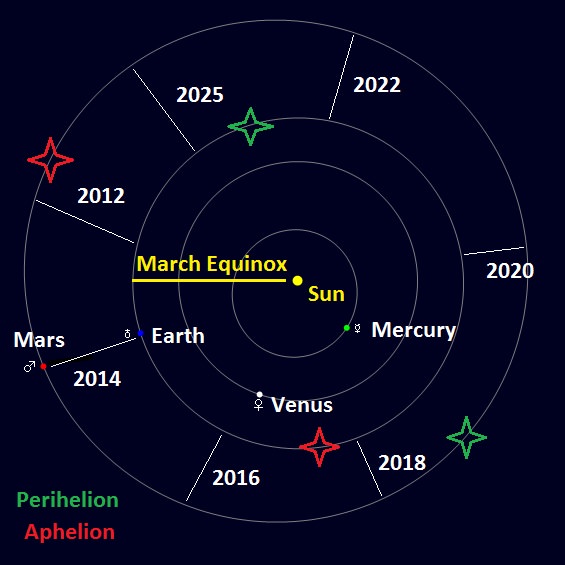
This guarantees that all oppositions of Mars – which occur roughly 26 months/780 days apart – are not created equal. In our current epoch, Mars can pass anywhere from 0.683 to 0.373 Astronomical Units (A.U.s) from the Earth. This year’s passage sees Mars overtake us at 0.62 A.U.s or over 96 million kilometres from Earth on the night of opposition. Mars is slightly closer to us at 0.618 A.U.s six nights later on April 14th.
Why the slight difference? Well, the speedier Earth is on the inside track headed towards aphelion in July, while Mars is lagging but headed slightly inward towards perihelion just afterwards in September. This combined motion makes for a slightly closer approach just after opposition until the Earth begins to pull away.
And this also means that Mars will make its apparent retrograde loop through Virgo on the months surrounding opposition:
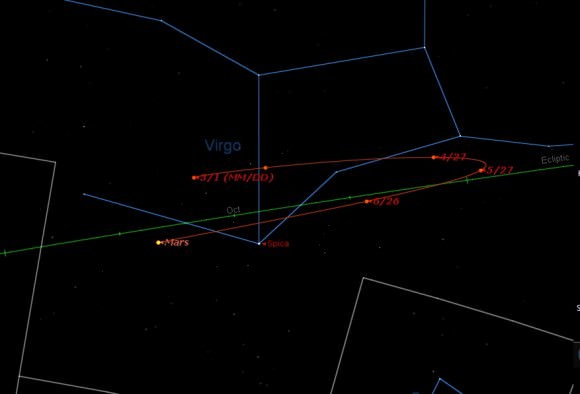
Now for the good news. Oppositions of Mars also follow a rough 15-year cycle, meaning that they get successively closer or more distant with every two year passage. For example, the 1999 opposition of Mars had a very similar geometry to this year’s, as will to the future opposition in 2029.
And we’re currently on an improving trend: the next opposition in 2016 is much better than this year’s at 18.6” in size, and during the 2018 opposition, Mars will present a disc 24.3” across and will be nearly as favorable as the one in 2003!
It’s also worth noting that Mars sits within four degrees of the rising Moon on the evening of April 14th. The bright star Spica also sits even closer to the Full Moon on the same evening, at less than two degrees away. This particular evening is also noteworthy as it hosts the first of two lunar eclipses for 2014, both of which favor North America.
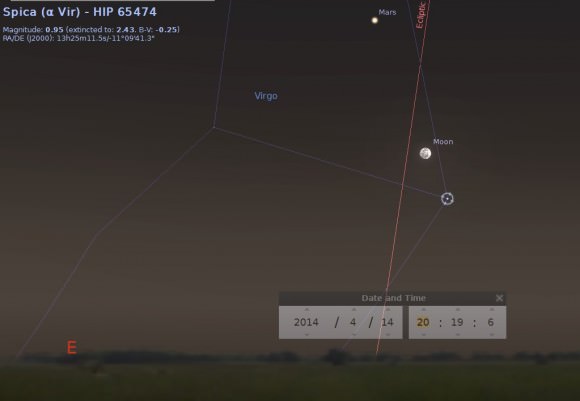
Can you catch Mars near the Moon before sundown on the 14th using binoculars? The Moon will also occult Mars on July 6th for viewers across central and South America.
Though Mars is nicknamed the Red Planet, we’ve seen it appear anywhere from a pumpkin orange to a sickly yellow hue. In fact, such a jaundiced color change can be a sign that a planet-wide dust storm is under way. Such a variation can be readily seen with the naked eye. What color does Mars appear like to you tonight?
On Mars, northern hemisphere summer starts on February 15th, 2014. This means that the northern pole cap of the planet is tipped towards us at opposition during 2014. The day on Mars is only slightly longer than Earth’s at 24 hours and 37 minutes, meaning that Mars will have seemed to rotated only an extra ~8 degrees if you observe it at the same time on each successive evening.
The white pole caps of the planet are the first feature that becomes apparent to the observer at the eyepiece. In February, Mars shows a noticeable gibbous phase in February as we get a peek at the edge of the nighttime side of the planet. Mars will be nearly “full” at opposition, after which it’ll once again take on a slightly distorted football shape.
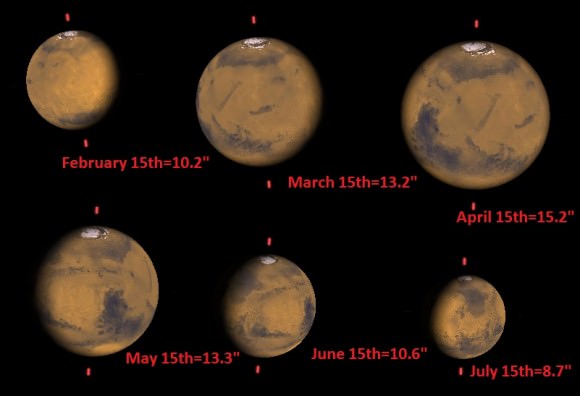
Tracking the features of the Red Planet is also possible at moderate magnification. One of the largest features apparent is the dark area known as Syrtis Major. Sky & Telescope has an excellent and easy to use application named Mars Previewer that will show you which longitude is currently facing Earth.
Sketching the regions of Mars is a fun exercise. You’ll find that drawing planetary features at the eyepiece can sharpen your observing skills and give you a more critical eye to discern subtle detail. And this season also provides an excellent reason to turn that newly constructed planetary webcam towards Mars.
Up for a challenge? Opposition is also a great time to try and observe the moons of Mars.
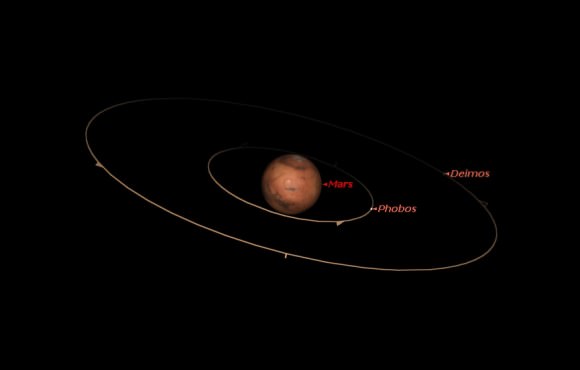
Phobos and Deimos are a tough catch, but are indeed within range of amateur instruments. The chief problem lies in their close proximity to dazzling Mars: +11.5 magnitude, Phobos never strays 14” from the Red Planet in 2014, and 12.4 magnitude Deimos never travels farther than 45” away. Phobos orbits Mars once 7.7 hours — faster than the planet rotates beneath it — and Deimos orbits once every 30.3 hours. The best strategy for a successful Martian moon hunt is to either place Mars just out of the field of view at high power when a moon reaches greatest elongation or block it from view using an eyepiece equipped with an occulting bar.
Extra credit for anyone who nabs pics of the pair!
And opposition is also “Visit Mars season,” as MAVEN and India’s Mars Orbiter Mission arrive later this year. In 2016, NASA’s Mars InSight mission is slated to make the trip, and the window is fast-closing for Dennis Tito’s proposed crewed fly-by mission of Mars in 2018.
And finally, to aid you in your quest for those elusive Martian moons, reader and human astronomical calculator extraordinaire Ed Kotapish was kind enough to compile a list of favorable apparitions of the moons of Mars on the weeks surrounding opposition. (see below)
Good luck, and be sure to send in those pics of Mars and more to Universe Today!
| ELONGATIONS OF THE MARTIAN MOONS DATES AND TIMES IN UT STARTING 3/30/2014 |
||
| MAR 30 PHOBOS 0300 W PHOBOS 0645 E DEIMOS 0900 W PHOBOS 1040 W PHOBOS 1425 E PHOBOS 1815 W PHOBOS 2205 EMAR 31 DEIMOS 0005 E PHOBOS 0155 W PHOBOS 0545 E PHOBOS 0935 W PHOBOS 1320 E DEIMOS 1515 W PHOBOS 1715 W PHOBOS 2100 E APR 01 APR 02 APR 03 APR 04 APR 05 |
APR 06 PHOBOS 0320 W PHOBOS 0705 E DEIMOS 0725 E PHOBOS 1055 W PHOBOS 1445 E PHOBOS 1835 W PHOBOS 2225 E DEIMOS 2230 WAPR 07 PHOBOS 0215 W PHOBOS 0605 E PHOBOS 0955 W PHOBOS 1340 EDEIMOS 1340 E (Mutual) PHOBOS 1735 W PHOBOS 2120 E APR 08 APR 09 APR 10 APR 11 |
APR 12 PHOBOS 0050 E PHOBOS 0440 W PHOBOS 0830 E PHOBOS 1220 W DEIMOS 1440 E PHOBOS 1605 E PHOBOS 2000 W PHOBOS 2345 EAPR 13 PHOBOS 0340 W DEIMOS 0550 W PHOBOS 0725 E PHOBOS 1115 W PHOBOS 1505 E PHOBOS 1855 W DEIMOS 2055 E PHOBOS 2245 E APR 14 APR 15 APR 16 APR 17 APR 18
|

